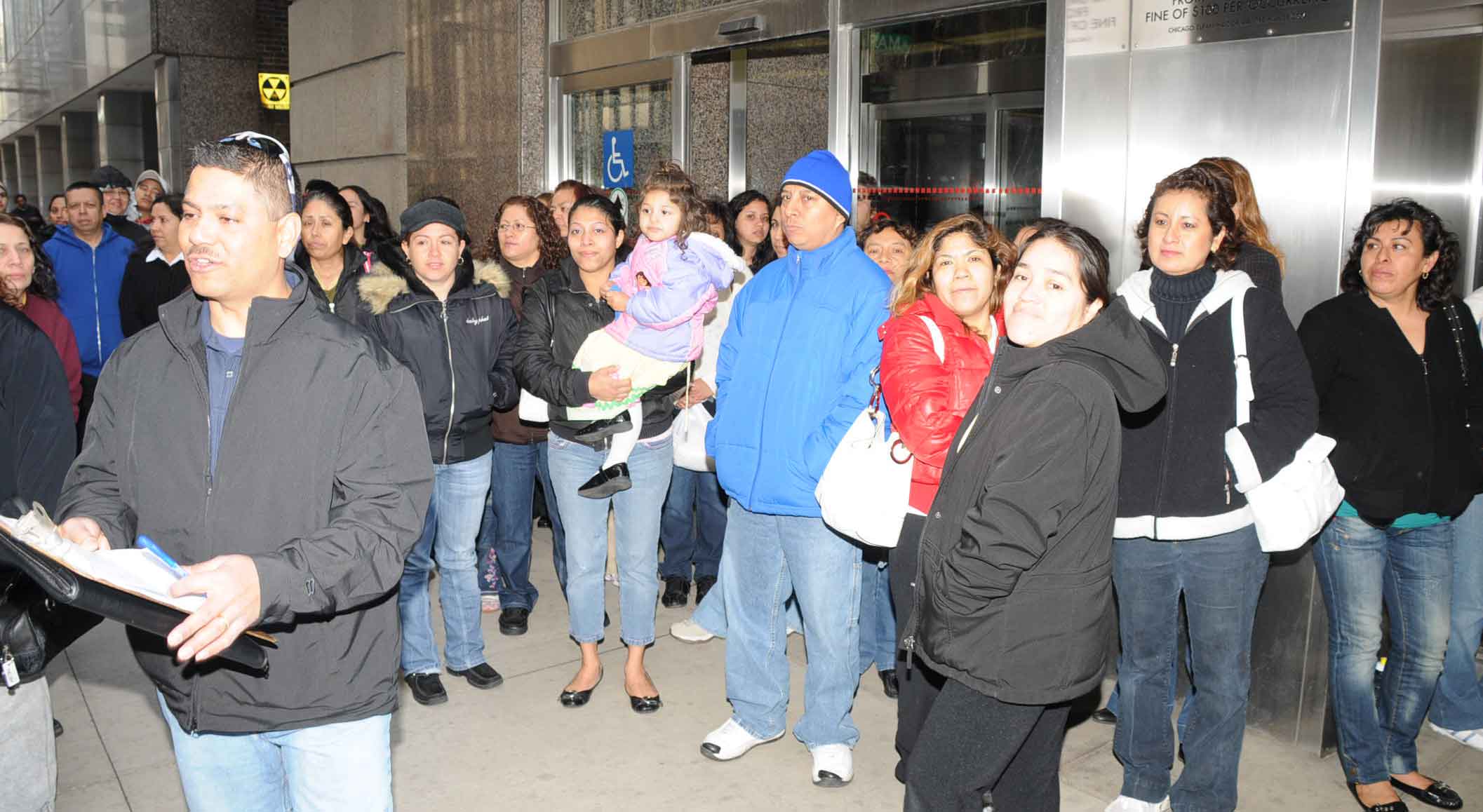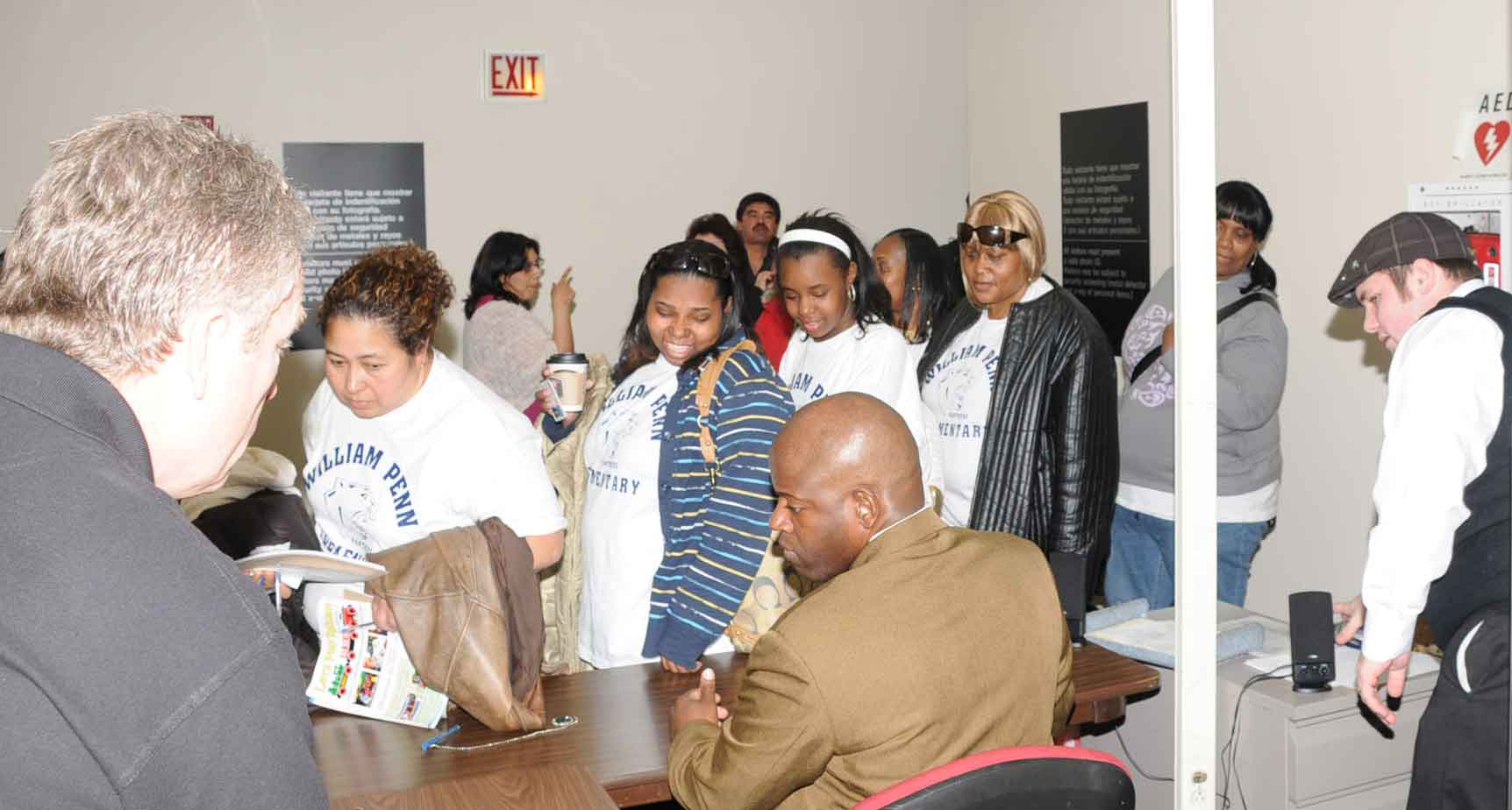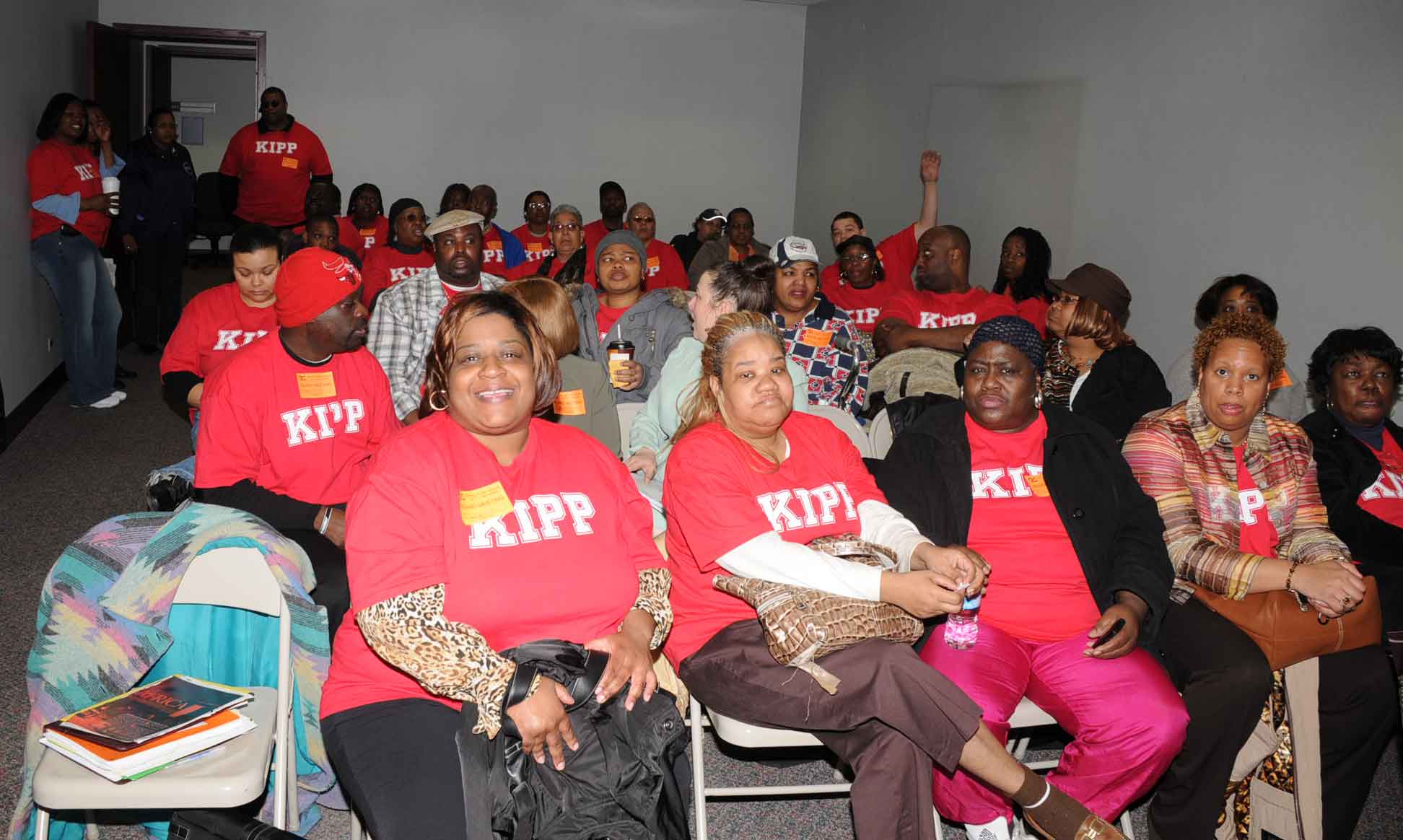Mayor Daley's school board closes area, limits access to Board meeting, to prevent protesters from being heard
More than 400 people, most of them African-American and Hispanic parents and children from public schools across Chicago, were barred from the Chicago Board of Education's headquarters on March 25, 2009, and prevented from presenting the school board with their testimony in opposition to a series of controversial proposals that were on the agenda of the Board's monthly meeting. The monthly school board meeting, held in the small "Board Chambers" on the fifth floor of the former Commonwealth Edison building at 125 S. Clark St., was then packed with Board of Education executive and clerical workers and a small number of people who had come downtown in support of the agenda before the Board of Education.
 Parents and community supporters of Mary Lyon Elementary School (2941 N. McVicker) tried to hold a press conference outside the headquarters of the Chicago Board of Education to protest the possible loss of more than 20 teachers and other staff because of Board of Education claims that their school was losing enrollment. Several buses filled with Lyon school protesters were ordered not to let their passengers out earlier in the morning because the Board of Education made a decision to keep out the hundreds of people organizing and arriving to protest against the policies on the agenda for that day. Substance photo by George N. Schmidt.While hundreds of people were reportedly prevented from getting off rented school buses and sent back to their schools in communities across the city, additional hundreds were barred from the fifth floor meeting rooms and held under security watch in "overflow rooms" on the sixth and 15th floors of the building. In the overflow rooms, they were forced to watch the meeting unfold on closed circuit television, but were not allowed to take building elevators to the fifth floor where the seven-member Chicago Board of Education was holding its monthly meeting. All of the Board members were appointed by Chicago Mayor Richard M. Daley. The Board members were holding what was supposed to be the once-a-month public meeting at which time members of the public are supposedly allowed to bring problems before the Board. The bottlenecks caused by the Board itself, along with the manipulation of the rules for public participation by administrative staff of the Board, gave the public and the Board members a completely distorted impression about the vast lack of support for a number of actions that were on the agenda of the meeting.
Parents and community supporters of Mary Lyon Elementary School (2941 N. McVicker) tried to hold a press conference outside the headquarters of the Chicago Board of Education to protest the possible loss of more than 20 teachers and other staff because of Board of Education claims that their school was losing enrollment. Several buses filled with Lyon school protesters were ordered not to let their passengers out earlier in the morning because the Board of Education made a decision to keep out the hundreds of people organizing and arriving to protest against the policies on the agenda for that day. Substance photo by George N. Schmidt.While hundreds of people were reportedly prevented from getting off rented school buses and sent back to their schools in communities across the city, additional hundreds were barred from the fifth floor meeting rooms and held under security watch in "overflow rooms" on the sixth and 15th floors of the building. In the overflow rooms, they were forced to watch the meeting unfold on closed circuit television, but were not allowed to take building elevators to the fifth floor where the seven-member Chicago Board of Education was holding its monthly meeting. All of the Board members were appointed by Chicago Mayor Richard M. Daley. The Board members were holding what was supposed to be the once-a-month public meeting at which time members of the public are supposedly allowed to bring problems before the Board. The bottlenecks caused by the Board itself, along with the manipulation of the rules for public participation by administrative staff of the Board, gave the public and the Board members a completely distorted impression about the vast lack of support for a number of actions that were on the agenda of the meeting.
Buses halted
Security staff ordered buses bringing parents and children from two schools on the city's north side and one school on the city's south side to leave the area when traffic began to jam along Clark St., three blocks south of City Hall, three hours before the Board meeting was scheduled to begin, according to informed sources.
CPS officials, who asked to remain anonymous because of the controversial nature of the Board's actions that day, told Substance that at least seven buses were told to leave the area because of traffic problems before 8:30 a.m. on the day the Board meeting was supposed to begin at 10:30 a.m.
 While parents and others from William Penn Elementary School (1616 S. Avers) were being forced to wait in line for more than an hour before going through metal detectors at the security checkpoint on the first floor of the Board of Education's headquarters, a large contingent from the KIPP Ascend charter school (see next photograph) had been escorted upstairs by staff from the Board of Education's Office of New Schools. The result was that when Penn's objections to the imposition of the KIPP school on their school were presented to the Board, the Board only saw a handful of parents, rather than the more than 100 who tried to attend the meeting. The KIPP contingent, on the other hand, was allowed to deploy fully inside the Board chambers. Substance photo by George N. Schmidt.The buses that were prevented from participating in the Board meeting included parents and children from Mary Lyon Elementary School on the north side and from Peck Elementary School on the south side. At least one bus carrying people from Penn Elementary School on the city's west side was also turned around and sent back to its place of origin. Substance is trying to confirm whether a bus from Columbia Explorers Elementary School on the south side was also diverted from the Loop on orders of Chief Executive Officer Ron Huberman.
While parents and others from William Penn Elementary School (1616 S. Avers) were being forced to wait in line for more than an hour before going through metal detectors at the security checkpoint on the first floor of the Board of Education's headquarters, a large contingent from the KIPP Ascend charter school (see next photograph) had been escorted upstairs by staff from the Board of Education's Office of New Schools. The result was that when Penn's objections to the imposition of the KIPP school on their school were presented to the Board, the Board only saw a handful of parents, rather than the more than 100 who tried to attend the meeting. The KIPP contingent, on the other hand, was allowed to deploy fully inside the Board chambers. Substance photo by George N. Schmidt.The buses that were prevented from participating in the Board meeting included parents and children from Mary Lyon Elementary School on the north side and from Peck Elementary School on the south side. At least one bus carrying people from Penn Elementary School on the city's west side was also turned around and sent back to its place of origin. Substance is trying to confirm whether a bus from Columbia Explorers Elementary School on the south side was also diverted from the Loop on orders of Chief Executive Officer Ron Huberman.
KIPP supporters pack Board meeting when KIPP presents
 While dozens of parents and children from Penn Elementary School were being bottled up at the metal detectors on the first floor of the Board of Education's headquarters at 125 S. Clark St. and prevented from appearing in the Board chambers when Penn's objections to the addition of KIPP to its building came before the Board, more than 70 people wearing KIPP tee shirts had been brought into the building and were seated in a room on the 15th floor awaiting their opportunity to cheer for KIPP. It was unclear what relationship many of the people wearing KIPP tee shirts had to the controversial charter school, and several refused to answer Substance questions about how and why they had gotten to the Board meeting. Substance photo by George N. Schmidt.Supporters of the KIPP Ascend charter school, which was on the Board agenda to share space with Penn Elementary School, were able to fan out in an array behind two speakers when the KIPP question came up. The KIPP supporters, all wearing red KIPP tee shirts, had been seated in the 15th floor overflow room prior to being brought downstairs to the Board chambers for the KIPP presentation.
While dozens of parents and children from Penn Elementary School were being bottled up at the metal detectors on the first floor of the Board of Education's headquarters at 125 S. Clark St. and prevented from appearing in the Board chambers when Penn's objections to the addition of KIPP to its building came before the Board, more than 70 people wearing KIPP tee shirts had been brought into the building and were seated in a room on the 15th floor awaiting their opportunity to cheer for KIPP. It was unclear what relationship many of the people wearing KIPP tee shirts had to the controversial charter school, and several refused to answer Substance questions about how and why they had gotten to the Board meeting. Substance photo by George N. Schmidt.Supporters of the KIPP Ascend charter school, which was on the Board agenda to share space with Penn Elementary School, were able to fan out in an array behind two speakers when the KIPP question came up. The KIPP supporters, all wearing red KIPP tee shirts, had been seated in the 15th floor overflow room prior to being brought downstairs to the Board chambers for the KIPP presentation.
An equal or larger number of parents and others from Penn Elementary School (1616 S. Avers), which was objecting to the KIPP placement in their building, were unable to get into the building, blocked at the metal detectors, or prevented from arriving at the fifth floor in time to stand in support of their speakers during the presentation.
Many of the schools that had been slated to receive "new schools" to "co-share" their buildings objected to both the process and the product, but were effectively blocked out of the Board of Education meeting at which their fate was decided. Ongoing manipulation of both Chicago's corporate media and the way in which the Chicago Board of Education's monthly meeting appears on Cable Television by CPS officials has ensured that most casual observers are not aware of the huge extent of protest and opposition to the Board's expansion of "Renaissance 2010" and a proliferation of so-called "new schools", most of which are charter schools.
Parents, community leaders, and even principals from a number of schools tried to object to the Board agenda, which included the placement of a half dozen "new schools" inside existing schools and additional "new schools" placements, which in some cases involved placing smaller schools inside schools which had just been closed because they were, according to one set of Board rules, too small.
South Chicago rejects EIPC but officially is enthusiastic about EPIC
One example of the process and product that was on display on March 26 was the fate of the South Chicago Elementary School, currently located in the former Sullivan Elementary School building, at 83rd and Houston in the South Chicago community.
Opposition to the closing of South Chicago Elementary, which was one of the best schools in the area for pre-school and elementary children, was widespread. The Board of Education ignored that opposition at its February 25 meeting, voting to close South Chicago. The supposed reason for closing the school was that it was "underutilized."
A large turnout of parents, community leaders, and students at hearings in January and February opposed the closing of South Chicago Elementary. Board of Education members ignored the hearings, and then did not read the hearing transcripts which reflected the unanimous opposition of the community to the proposed closing. The Board voted to close South Chicago unanimously and without debate on February 25, 2009.
A month later, the Board's Office of New Schools held a hastily convened "hearing" on a proposal to open a "new" school for 150 students on the South Chicago Elementary site. Despite widespread opposition to the closing of the old school and widespread opposition to the "new school" as well, the Board of Education voted on March 25 to place the "new school" inside the South Chicago building.
In effect, the Board was voting to close a school with more than 200 students because it was "too small" and then to open a "new school" in the same building that was even smaller.
But anyone who watched the March 25 Board meeting on TV would not know that. The presentation on behalf of the "new school" was done without opposition before the Board on March 25, with the presenters even claiming that the school had "widespread community support," which is not true.
Board members spent time during the public participation agenda making small talk with groups from charter and other "new schools", thereby running out the clock as well. During part of the meeting, Board President Michael Scott left the chair and turned it over to vice president Clara Muñana. Muñana made sure she talked for at least one minute after each privatization presentation.
Manipulating media and perception
One of the ways in which the Duncan and Huberman administrations have manipulated media is by trying to prevent teachers, principals and others from attending Board of Education meetings and objecting to various Board proposals.
At the December Board meeting, a number of teachers organized by CORE spoke out at the Board meeting in opposition Renaissance 2010. By the time three of them returned to their schools the following day, their principals had received phone calls from Chief Executive Officer (New Schools) Joshua Edelman or Chief High Schools Officer David Gilligen to their principals. Edelman and Gilligan demanded to know why the teachers had been allowed to speak out against the policies of Mayor Daley and "Renaissance 2010."
At one point, the Chicago Teachers Union, which is supposedly working within the GEM coalition against the expansion of Renaissance 2010, also joined in helping the Board's attempt to prevent teachers from speaking out against the privatization plan. During meetings with teachers and community leaders and at the union's February House of Delegates meeting, CTU president Marilyn Stewart and the union's attorney Jennifer Poltrock distributed materials claiming that it might be illegal for teachers to use personal business days to protest Board policies such as Renaissance 2010. Although Stewart has continued to speak out against some aspects of the program, she has at the same time been trying to prevent independent organizing by teachers against the broader expansion of privatization and charter schools in Chicago.
Final SubstanceNews article posted at 5:00 a.m. March 27, 2009. Copyright 2009 Substance, Inc. all rights reserved. If you use or reprint this article or any of the photographs accomanying it, please report the following: "Copyright 2009 Substance, Inc., www.substancenews.net, with permission." Then contact Substance for details.

